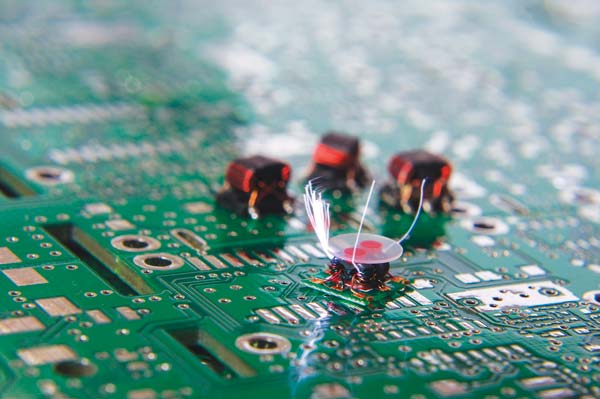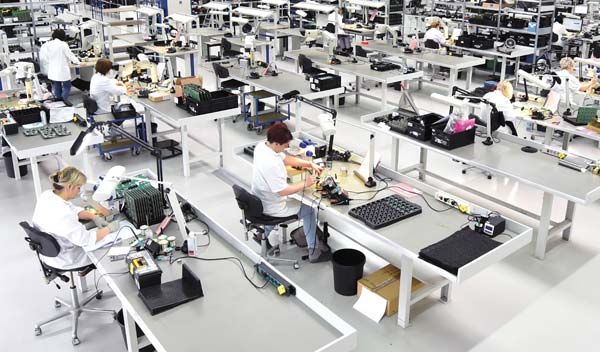 An Ever-Present Threat
An Ever-Present Threat
Unless preventative measures are in place, people or objects can accumulate electrostatic charge through a variety of mechanisms. Friction is a frequent cause: a person simply walking across a carpet can become charged to about 35,000V. It sounds frightening, but the energy contained in an electrostatic discharge (ESD) from such a high potential is mostly harmless to humans. On the other hand, electronic components such as CMOS chips that can have feature sizes of just a few nanometres, as well as analogue ICs, and even small passive components such as film resistors, can be badly damaged by ESD at voltages as low as 250V.
Depending on the device structure and materials, and the characteristics of the discharge such as voltage, total energy, current, and duration, damage can include melting or evaporation of internal conductors and dispersion of metal into other areas potentially causing short circuits. Damage can be so severe that the device is unable to function. On the other hand, partial damage to connections, oxide layers or other internal features may simply degrade component performance or – perhaps more serious – create latent defects that are not detected immediately. Latent defects compromise reliability, with the result that aging, electrical stress, normal thermal cycling, or even vibration experienced during use can lead to failure in the field.
Whole-Life Protection
Obviously, any type of ESD damage is undesirable and should be prevented. When connected in-circuit, static-sensitive devices can be protected by components designed specifically to suppress or divert the discharged energy. Depending on the application these can range from small transient-voltage suppressor (TVS) diodes to crowbar devices or gas-discharge tubes (GDTs). The IEC 61000 series of standards specifies system-level ESD-withstand capabilities for various categories of products.
However, from the point when ESD-sensitive components are manufactured until reaching the protected haven of the circuit board, they can be vulnerable to damage. Hence the components are at risk throughout activities such as production, packaging, labelling, servicing, testing, inspection, transportation, and final assembly. The standard covering ESD safety for components at these stages is IEC 61340-5-1:2016.
Electronic manufacturers, whether OEMs or service providers, should maintain goods-in and inventory-handling policies that meet IEC 61340-5-1 to ensure components are always treated carefully and protected from ESD. Even before purchased components arrive at goods-in, they need credible assurances from the supplier that stock is handled properly to prevent damage. They should certainly check that adequate safeguards are in place; there is no harm in arranging a visit to make absolutely sure.
 Expert Knowledge
Expert Knowledge
Bürklin teamed up recently with ESD Protect, which has specialist knowledge of ESD and industry best-practice, to review all aspects of in-house component handling, encompassing goods-in reception and checking, consignment to Bürklin inventory, component picking, and re-packaging and preparing for despatch. We also retrained our staff in the latest ESD-safe handling practices and we have also installed new storage and packaging facilities with continuous monitoring of relevant measured values.
Following teamwork spanning several months, we have achieved IEC 61340-5-1 and ANSI/ESD S20.20 certifications for our ESD control program. As a result, we are no longer dependent on original manufacturer packaging and can now offer smaller quantities of ESD-sensitive products to satisfy our customers’ individual requirements and specifications, while ensuring full protection meeting the highest standards.
Moreover, the company’s partnership with ESD Protect also lets us offer tailored consulting services for customers and their staff, to help extend best practice throughout the entire supply chain. These range from general seminars describing ESD-safe handling for components, to individual consulting and auditing at customers’ premises.
We can also help setup a proper electrostatic protected area (EPA) for preparing components that are vulnerable to ESD, in accordance with IEC61340-5-1, and provide suitable equipment for the necessary grounding and bonding. Our product portfolio contains not only the usual items such as personal grounding devices, workwear, and equipment clamps but also less obvious requisites such as ESD-safe office furniture, drawer inserts, and cleaning consumables.
Contact Bürklin today to find out exactly how to ensure the best possible ESD safety for your components, from the original manufacturer all the way to your assembly line.
Author: Alfred Lipp,
General Manager Sales & Marketing at Bürklin GmbH
About Bürklin
Year of foundation: 1954; Employees: 160
Bürklin Elektronik is a distributor specialized in high quality electronic components. For our commercial and private customers, we have more than 75,000 articles from over 500 manufacturers in stock. We are continuously expanding this range and can currently offer more than 1,800,000 items. In addition, we are happy to procure other products from all renowned manufacturers worldwide.
We sell our products via our online shop and in our retail outlet at our company headquarters in Oberhaching near Munich. For more than 65 years, our family-run company has stood for first-class service and a high level of specialist trade competence.
We are a classic distributor. Bürklin Elektronik focuses on the customer. We therefore attach great importance to professional customer management. Here our customers receive advice over the telephone and incoming orders are swiftly processed. Our customer service team is also responsible for fulfilling customer-specific requests. Our goal is to always satisfy our customers, who are at home all over the world. To this end, we are also broadening our customer relationship and key account management activities.
Our main markets are:
• Industrial automation
• Automotive
• Consumer
• Data/Computing
• Instrumentation
• Medical technology
• Transport & Infrastructure



